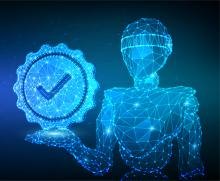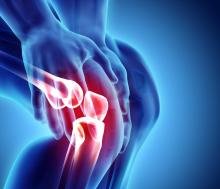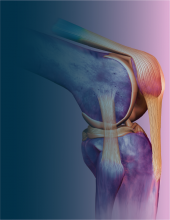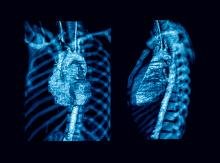By: Estefanía Fajardo, Dr César Graf
INTRODUCTION
Artificial Intelligence (AI) is a term coined in 1955 by John McCarthy, Professor Emeritus at Stanford University. He defined this concept as “the science and engineering making intelligent machines” (1).
It is the part of IT studying the simulation of human intelligence.
For this purpose, it uses a set of hardware and software with a brain-inspired neural network format, which creates mathematical algorithms taken from verbal, written or numerical data, to store, analyze, process, and compare them, giving a fast, automatic, and intelligent response that allows it to solve complex problems with a high level of accuracy and evidence.
In other words, Artificial Intelligence allows machines to have a rational behavior, like human beings, maximizing its changes of success.
As such, artificial intelligence not only emulates human intelligence, but even surpasses it by performing tasks and functions that, in no way, a human could perform, such as storing thousands of data (Big Data), analyzing them (Data Analytics), learning from itself (Machine Learning) and identifying behavioral patterns and trends in seconds, formulating automatic predictions.
The first studies on this concept date back to 1950, when Alan Turing published a paper titled “Computing Machinery and Intelligence”. Turing (1912-1954), British mathematician, is considered the father of artificial intelligence. He was famous for decoding the encryption of German Enigma machines during the second world war and was a pioneer in different branches of knowledge, whose contribution is essential in the development of current technologies.
Marvin Minsky is another pioneer in the field of artificial intelligence. He dreamed of endowing machines with human intelligence so that they could learn, solve problems, and offer solutions without our intervention. In 1951, he built the first artificial neural network capable of learning, called SNARC (Stochastic Neural-Analog Reinforcement Computer), which is we know today as Machine Learning.
In 1956 took place the first Dartmouth Conference on Artificial Intelligence. There, the scientists who marked a milestone in the history of this specialty came together. That conference was the result of a proposal wrote by John McCarthy, Marvin Minsky, Nat Rochester, and Claude Shannon, where they proposed a 2-month, 10-man study on artificial intelligence. They were the ones that baptized this new field of study, and therefore are considered the fathers of artificial intelligence.
One could say that much research has led to machines being programmed to behave in a similar way to human intelligence, so that, through applied algorithms, they can learn, solve problems, and provide solutions quickly, automatically, and safely without our intervention.
For instance, in the era before powerful computers and big data, such systems were programmed by humans and followed the rules of human invention, but advances in technology have led to the development of new approaches.
One of them is machine learning, today the most active area of AI, in which statistical methods allow a system to "learn" from data and make decisions, without being explicitly programmed. Such systems combine an algorithm, or a series of steps to solve a problem, with a knowledge base or stream: the information that the algorithm uses to build a model of the world. (2)
In a two-parts text, we will explore in depth the concepts of artificial intelligence and its application in medicine. In this first part, in addition to the definitions of AI as we have developed in the introduction, we will review its applications at a general level, its achievements, uses and challenges, and then, in a second part, we will focus on the relationship between artificial intelligence and rheumatology, its application in the specialty and the challenges for specialists and for patients, as well as what is believed to come in the future.
USES IN MEDICINE
Until a few years ago, artificial intelligence was a technology unknown to many, associated to futuristic science fiction movies. Now, it is a reality.
It is clear in many ways that AI can play an important role in the development of personalized medicine. The potential of this in medicine is enormous and, compared with conventional statistics, offers a plethora of new possibilities. (3)
Smart technologies allow to have a 4P approach in medicine (predictive, preventive, personalized and participatory); for example, smartphones are becoming a reference element for completing and distributing an electronic personal health record, monitoring vital functions with biosensors, and helping to achieve optimal therapeutic compliance, thus giving the patient the place as the main actor in the care pathway. (4)
In this regard, a number of fundamentally ethical and moral questions have been raised about artificial intelligence-driven health interventions, and whether the tools, methods, and protections traditionally used for evidence- or experience-based decision making would also apply to new technologies. (5)
The global health community has increasingly recognized the urgency of addressing these issues to ensure that populations in developing countries benefit from advances and innovations in digital health and artificial intelligence (6). In these countries, the deployment of artificial intelligence has already begun for a wide range of health problems with interventions focused primarily on communicable diseases, including tuberculosis and malaria.
BIG DATA
To begin with, it is worth noting that big data is a relatively recent term -introduced in the 1990s- whose purpose was to include data sets that were too large to be used with regular software.
Medicine is an important field that is expected to significantly increase the use of big data from 2025 and beyond. Big data in medicine can be used by commercial, academic, government and public sectors. In addition, it includes biological, biometric, and electronic health data. (7)
Big data serves to analyze from purchasing behaviors to crime statistics, weather patterns, outbreaks of diseases, among others. Big data allows for the integration of information extracted from heterogeneous sources, as well as its analysis under precise control, modeling for subsequent interpretation and validation.
DEEP LEARNING
Deep learning is a sub-discipline of artificial intelligence that has shown multiple successes in clinical applications (8) involving melanoma imaging data (9), retinopathy (10), metastatic breast cancer (11), and other biomedical areas (12) and healthcare (13, 14). Deep learning is being applied to an increasing number of electronic health record-related data sets (15) and, as with the application of technology to any new field, there are plenty of opportunities and challenges (12,16).
MAIN USES
The main uses of artificial intelligence and its different areas cover several domains. Figure 1 summarizes the main uses where there is evidence of the benefit of the use of technologies in the healthcare sector, dividing this into four main groups: patient care, medical imaging and diagnostic, research and development, and management.
Applications of Artificial Intelligence in Rheumatology
Source : From Reference 17: Dilmegani W by C, Dilmegani C. Top 18 AI applications / use cases / examples in healthcare [Internet]. AI multiple. 2017. Available in: https://research.aimultiple.com/healthcare-ai/
The first group, patient care, addresses aspects such as diagnosis and assisted prescription, which can be very helpful with tools such as the chatbots. Also, AI audit systems, as well as pregnancy monitoring and management and real-time prioritization and triage.
The uses considered in this first group also addresses personalized care and medication, which allows reducing costs and increasing the effectiveness of care, in addition to the analysis of patient data suggesting actions or providing knowledge about the patient's condition. Finally, in this group we have also the surgical robots.
The second group addresses early diagnosis by leveraging laboratory data and chronic conditions, as well as information on medical images that allow the modeling of different scenarios. Research and development include elements such as drug discovery, gene analysis and editing, and the comparative effectiveness of drugs and technologies.
Finally, in the management group, AI addresses aspects such as brand management; pricing and risk considering market conditions, market research, operations, chatbots, and fraud detection.
CONCLUSIONS
Although artificial intelligence is not something new, several advances are being made, especially during the last few years. Therefore, we can say -without fear of error- that it is ready for prime time, recognizing the application of technologies in the field of medicine and the support they can provide to health professionals.
It is important to bear in mind that providing physicians with the skills, resources and support needed to use artificial intelligence-based technologies is essential for the successful implementation of artificial intelligence in healthcare. To do so, physicians must have a realistic understanding of the potential uses and limitations of medical applications. (18)
Furthermore, it is wise to balance the need for thoughtful and inclusive health care artificial intelligence that actively plans and manages and reduces potential unintended consequences. (19)
There is a clear need to develop standardized, reliable, evidence-based reporting guidelines for AI clinical trials and relevant studies used to evaluate the usefulness of such technologies (18), as we know that there is a long way to go and legislation pending on ethics and applicability, as well as the use of these data and how to share them for research.
There is also a challenge to go further and address the needs of patients and the community. This technology has the potential (with appropriate consent) to connect personal and public data for truly personalized health care. (19)
In the second part we will talk about these fundamental aspects to consider in the rheumatology practice.
REFERENCES
- Artificial Intelligence Definitions [Internet]. Stanford.edu. Disponible en: https://hai.stanford.edu/sites/default/files/2020-09/AI-Definitions-HAI.pdf
- Harvardmagazine.com. Disponible en: https://www.harvardmagazine.com/2019/01/artificial-intelligence-limitations
- Hügle M, Omoumi P, van Laar JM, Boedecker J, Hügle T. Applied machine learning and artificial intelligence in rheumatology. Rheumatol adv pract [Internet]. 2020;4(1):rkaa005. Disponible en: https://academic.oup.com/rheumap/article/4/1/rkaa005/5740589?login=true
- Briganti G, Le Moine O. Inteligencia artificial en medicina: hoy y mañana. Front Med (Lausana) [Internet]. 2020;7:27. Disponible en: http://dx.doi.org/10.3389/fmed.2020.00027
- Schwalbe N, Wahl B. Artificial intelligence, and the future of global health. Lancet [Internet]. 2020;395(10236):1579–86. Disponible en: https://www.sciencedirect.com/science/article/pii/S0140673620302269
- USAID’s Center for Innovation and Impact (CII). Artificial intelligence in Global Health: Defining a Collective Path Forward [Internet]. Usaid.gov. Disponible en: https://www.usaid.gov/sites/default/files/documents/1864/AI-in-Global-Health_webFinal_508.pdf
- Mallappallil M, Sabu J, Gruessner A, Salifu M. Una revisión de Big data e investigación médica. SAGE Open Med [Internet]. 2020;8:2050312120934839. Disponible en: http://dx.doi.org/10.1177/2050312120934839
- Greenspan H, Ginneken BV, Summers RM. Aprendizaje profundo en imágenes médicas: descripción general y promesa futura de una nueva técnica emocionante. IEEE Trans Med Imaging. 2016;35(5):1153-1159.
- Esteva A, Kuprel B, Novoa RA, et al. Clasificación a nivel dermatólogo del cáncer de piel con redes neuronales profundas. naturaleza _ 2017;542(7639):115-118.
- Gulshan V, Peng L, Coram M, et al. Desarrollo y validación de un algoritmo de aprendizaje profundo para la detección de retinopatía diabética en fotografías de fondo de retina. JAMA. 2016;316(22):2402-2410.
- Wang D, Khosla A, Gargeya R, Irshad H, Beck AH. Aprendizaje profundo para identificar el cáncer de mama metastásico. Impresiones electrónicas ArXiv. 2016. https://ui.adsabs.harvard.edu/#abs/2016arXiv160605718W
- Ching T, Himmelstein DS, Beaulieu-Jones BK, et al. Oportunidades y obstáculos para el aprendizaje profundo en biología y medicina. Interfaz JR Soc. 2018;15(141):20170387
- Miotto R, Wang F, Wang S, Jiang X, Dudley JT. Aprendizaje profundo para el cuidado de la salud: revisión, oportunidades y desafíos. Breve Bioinforme. 2018;19(6):1236-1246.
- Miotto R, Li L, Kidd BA, Dudley JT. Paciente profundo: una representación no supervisada para predecir el futuro de los pacientes a partir de la historia clínica electrónica. Representante científico 2016;6:26094.
- Shickel B, Tighe PJ, Bihorac A, Rashidi P. Deep EHR: una encuesta de avances recientes en técnicas de aprendizaje profundo para el análisis de registros de salud electrónicos (EHR). IEEE J Biomed Salud Informar. 2018;22(5):1589-1604.
- Norgeot B, Glicksberg BS, Butte AJ. Un llamado a la atención médica de aprendizaje profundo. Nat Med. 2019;25(1):14-15.
- Dilmegani W by C, Dilmegani C. Top 18 AI applications / use cases / examples in healthcare [Internet]. AIMultiple. 2017. Disponible en: https://research.aimultiple.com/healthcare-ai/
- James CA, Wachter RM, Woolliscroft JO. Preparando a los médicos para un mundo clínico influenciado por la inteligencia artificial. JAMA. Publicado en línea el 21 de marzo de 2022. doi:10.1001/jama.2022.3580
- Matheny M, Sonoo T, Israni M, Ahmed D, Edu N. Inteligencia artificial en el cuidado de la salud: la esperanza, la exageración, la promesa, el peligro [Internet]. Nam.edu. Disponible en: https://nam.edu/wp-content/uploads/2021/07/4.3-AI-in-Health-Care-title-authors-summary.pdf













































































































































































































